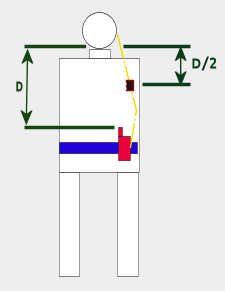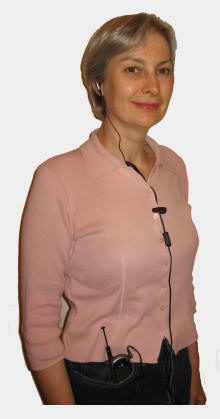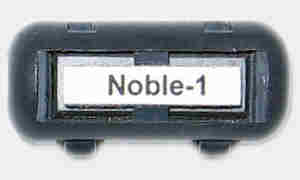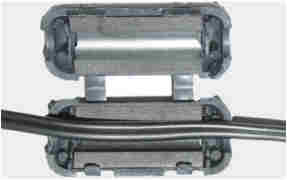
|
-
 How To Use Noble1, The RfReduce Device - Cell Phone Accessory. How To Use Noble1, The RfReduce Device - Cell Phone Accessory.
-
 How The RF Of The Cell Phone Tries To Get To Your Head. How The RF Of The Cell Phone Tries To Get To Your Head.
-
 Using A RF Reduction Device At The Bottom Of The Ear Piece Wire - This Is Non-Sense Using A RF Reduction Device At The Bottom Of The Ear Piece Wire - This Is Non-Sense
-
 Worst Case Attenuation (WCA). What It Is. What It Means. Worst Case Attenuation (WCA). What It Is. What It Means.
-
 Laboratory Results Laboratory Results
-
 The Air Phone - Is This A Good Idea? The Air Phone - Is This A Good Idea?
-
 Are Speaker Phones A Good Idea? Are Speaker Phones A Good Idea?
-
 BlueTooth Wireless Earpiece Accessory - A Really Bad Idea BlueTooth Wireless Earpiece Accessory - A Really Bad Idea
-
 What About Protective (Metal) Bags? What About Protective (Metal) Bags?
-
 What About Protective Crystals? What About Protective Crystals?
-
 How Does One Compare Effectiveness of Different RF Absorbers? How Does One Compare Effectiveness of Different RF Absorbers?
- How To Use Noble1, The RfReduce Device - Cell Phone Accessory.
You can use our Noble 1 RF reduction device when you have a wired earpiece/microphone connected to your Cell Phone. One approach to using our device will be to put your Cell Phone on your belt and have the wire for the earpiece/microphone coming up to your ear. In the figures below we show our model wearing the Noble1, as well as a diagram showing the placement of the Noble1 half-way between the chin and the waist.
Let's ensure that the different parts on the photo are understood. We will start at the top.
- At the very top of the ear piece wire is the little earphone that inserts into the ear.
- As you come down the wire, you will see the microphone that picks up the voice of whoever is using the Cell Phone.
- Continuing down, you see a clip that is attached to the shirt. This keeps the ear piece wire from bouncing around too much and it also holds the weight of the lower part of the wire and the weight of the Noble1.
- Below that you see the Noble1 that has been attached to the ear piece wire, as will be discussed and demonstrated, below.
- At the very bottom, of course, we have the Cell Phone.


Open The Device.
The device is a clam shell arrangement. There are 2 small plastic clip/snaps that hold the device closed. Carefully push the clips away from (out from) the device and open the clam shell. The figure below shows the Noble1 device closed, before a wire is passed through it.

Run The Wire Through One Or Two Times.
In the following figure, the Noble1 is shown open with one wire passing through it, and the device is still open.

You may run the earpiece/microphone wire through the device one time or you may run it through the device two times. In general you will get more effectiveness out of the device by running through two times. In a later paragraph on this page we give the actual effectiveness figures that we achieved in our laboratory tests and it shows that in general two times through is more effective.
In the following figures we show the Noble1 with either one wire passing through it or with that same wired wrapped around the device so that it goes through the center of the Noble1, two times.


Close The Device.
After running the wire through one or two times, snap the clam shell shut and be sure not to pinch the wires. You want the clam shell to be fully closed to get the maximum effectiveness. If you can't get two pass throughs of the ear piece wire, don't worry about it. It is important that the Noble1 device be fully closed.
Leave It Closed.
Once you have clamped the clam shell closed, you will probably leave it just like that for most or all of the time that you are using it.
Plastic Hinge.
You may notice that the hinge on the Noble1 device is plastic. If you open and close it many times it may eventually break.
- How The RF Of The Cell Phone Tries To Get To Your Head
The antenna of your Cell Phone is radiating Radio Frequency (RF) energy into the space around it. All RF energy has a wavelength. The wavelengths of Cell Phone RF are quite small, and are therefore referred-to as "microwaves". Some of this RF (microwave) energy couples into (gets onto) the ear piece wire that is going from your Cell Phone to the ear piece that is positioned in your ear. The wire, usually of a primarily copper construction, is quite happy to carry the RF. It can carry it reasonably efficiently up to your head. All that wire has to do, is to carry it more efficiently than the same RF would travel through the air to your head, and we have the situation where using a wired ear piece has worsened (increased) the radiation level at your head.
We have made specific measurements of the coupling of the RF to the ear piece wire. Said another way, we have measured, in our microwave laboratory, how "well", how "much", the RF that is coming off the antenna, can get into the ear piece wire and therefore travel to your head. By the way, a "microwave laboratory" is a laboratory where various microwave frequencies can be generated and measured.
We have found that, approximately 10% of the radiated power can couple into the ear piece wire. This is a fairly high number. Said another way, "it's a lot".
By using the Noble1 device, this "a lot" can be reduced. The Cell Phone is, in effect, "trying" to get the RF to your head by travelling along the ear piece wire, but the Noble1 reduces the RF intensity. It reduces the strength of the RF energy. In a later section, on this page, will give specific figures for this reduction.
- Using A RF Reduction Device At The Bottom Of The Ear Piece Wire - This Is Non-Sense.
We have seen competitors recommendations that show the use of a RF reduction device, around the ear piece wire at the bottom of the wire. In other words the RF reduction device is very close to where the ear piece wire comes out of the Cell Phone. This does not make sense. This is a testimony that the person or organization suggesting to use their RF reduction device in this way has a fundamental misunderstanding of the physics of this phenomenon.
Cell Phone manufacturers ensure that there is no RF leaking out of the ear piece jack. The problem that occurs is that the radio frequencies that are radiating from the antenna, through space, are coupling to (getting onto) the ear piece wire. The RF reduction device needs to be above the antenna, not at the antenna or below the antenna.
- Worst Case Attenuation (WCA). What It Is. What It Means.
NOTE: Attenuation means reduction.
Theory Of Operation
We want to first mention, the basic operation of the the Noble1 and then discuss WCA.
The Noble1 device is a "ferrite absorber". Ferrite is an alloy of iron and any number of other, often exotic materials that absorb electromagnetic energy, including what we call Radio Frequencies. The ferrite converts this electromagnetic energy into a very small amount of heat.
Now, concerning WCA... It will be a little bit difficult to explain this to non-technical readers. We use an analogy to try to convey why this is a particularly difficult problem to solve. We will include enough technical discussion to satisfy the engineer or scientist who may be reading this.
Here goes the analogy.
Imagine that you are training aircraft pilots to fly a single-seat airplane that is a very high performance machine and is very difficult to control. Imagine also, that these trainees have never driven an aircraft before - ever. Wow, that would be tough. How do you do it?
Well, you can design and build an electro-mechanical flight simulator. (As you probably know this has been done many times.) When the trainee gets into the simulator it "acts like, and feels like" the real airplane. The simulator behaves like the real plane and can take the trainee through every possible flight condition. Assuming that the simulator is faithful to the real airplane, then a trainee can become adept at flying - the actual plane.
The Noble1
To bring this all back to the Noble1 RF reduction device, there is a similar situation. An RF reduction device like the Noble1 operates in a circuit that has a specific impedance. Impedance is the relationship between the voltage and current in the circuit. If we are to measure, and to specify in literature, the reduction effectiveness of the device, we need to know what that impedance is.
Unfortunately that impedance varies with the installation environment. The installation environment includes:
- the diameter of the ear piece wire
- the thickness of the ear piece wire insulation
- the length of the ear piece wire
- how close the ear piece wire is to the person who is wearing it
- the proximity of any other body parts, like a hand or an arm
- the proximity of other wires from other devices
- the proximity of other electrically conducting appliances
- etc.
Many times, manufacturers will specify the reduction of such a device when it is used in a 50 ohm (impedance) system. As long as the application for such a device is indeed a 50 ohm system, then these reduction figures are meaningful. If the impedance is something else, the, the 50 ohm specifications are meaningless and not useful.
When we look at competitors products (competitors to the Noble1 device) we not only, do not see specifications for RF reduction for the devices they offer, but we do not see any appreciation of how difficult it is to specify reduction and therefore understand whether the product they are offering, works at all.
NOTE: Attenuation means reduction.
Worst Case Attenuation is a measurement approach that basically looks at all possible impedance conditions and finds that condition, where the reduction device behaves the most poorly - the worst. The "worst" then, is the specification. If the impedance in the actual usage is not the same as the Worst Case, then, the reduction achieved in the actual usage will be better than the worst case. "Better than" means that the RF is reduced more. Clearly then, the Worst Case Attenuation (reduction) is the only measurement, the only specification that means anything!
As any microwave engineer will tell you, after reading this page, the job of finding the Worst Case Attenuation is a tedious, time-consuming job. It is though, the only approach. Any other approach has no basis for expectation of performance (how much reduction) in actual usage.
- Laboratory Results
We tested a variety of RF reduction products from different vendors. Included in these are products that were marketed by various companies where the stated application was the reduction of Cell Phone RF. In the chart below we show some of the data we collected in our microwave laboratory.
Let's define some terms.
Attenuation is the technical term for reduction. It can be expressed in various units. The most common is "db". "db" stands for decibel. It is 1/10 of a bel. "db" is a logrithmic measure. This means that small changes in the db number denotes large changes in the quantity being measured.
We are interested in the reduction of RF power. We are interested in reducing the RF power that is travelling up the ear piece wire from a Cell Phone. When we give a db number it will reflect how much this RF power has been reduced.
Remember: "attenuation" means reduction.
We will also give the reduction as a percentage, since most non-technical readers will understand this more easily.
In our testing, we found that the size (gauge) of the wire, the ear pice wire that is, played a significant part in the Worst Case Attenuation measurement. In addition we found that the thickness of the wire insulation played a part.
The larger the gauge of the wire, the greater the reduction (Worst Case Attenuation).
The smaller the thickness of the wire insulation, the greater the reduction (Worst Case Attenuation).
These findings can be understood from what is known as "coupling". The larger the wire gauge (wire diameter), the closer the outer edge of the wire is to the ferrite material that is inside the Noble1 device.
Similarly, the smaller the thickness of the wire insulation, again, the closer the outer edge of the wire is to the ferrite material that is inside the Noble1 device.
Both of these couple more RF energy into the ferrite that is inside the Noble1 device and this is exactly what we want to get the most reduction (attenuation).
In our testing we found that going from "1 loop" (one pass of the wire through the RF reduction device) to "2 loops" increased the reduction (this is good) in a range from 2 db to 8 db. The differences varied according to wire gauge and insulation diameter. In the chart below, we have always used the 2 db improvement since it is the most conservative.
| Item |
Device Being Tested |
1-Loop, db Reduce |
1-Loop, % Reduce |
2-Loop, db Reduce |
2-Loop, % Reduce |
Comment |
| 1 |
Noble1 Med. Gauge Wire |
11.5 db |
93 % |
13.5 db |
95 % |
Most Conservative Noble1 Results |
| 2 |
M |
4.8 db |
70 % |
6.8 db |
79 % |
Competition |
| 3 |
K |
7.1 db |
80 % |
9.1 db |
88 % |
Competition |
| 4 |
A |
8.5 db |
86 % |
10.5 db |
91 % |
Competition |
- The Air Phone - Is This A Good Idea?
There is a Cell Phone ear piece that is referred-to as an "air phone". It has a wired connection to an audio transducer module. From this module, a hollow tube brings the sound to the ear. The tube is plastic. The idea here is that the tube will not conduct the RF to the person's head.
We are often asked whether this is a viable approach to reduce Cell Phone RF to the head. As long as the length of the tube is such that it extends down to a location that is approximately 1/2 of the distance from the waist to the chin then this approach is effective. Some of these products that we have seen are sized so that the air tube only extends from the ear, down to the chin (of the person wearing it). If you are going to use such a device you might consider trying to get a model that extends the tube down to a point that is 1/2 way between the chin and the waist (of the person who is wearing it).
It may be a bit more bulky and heavier then our Noble1 device. It's cost might be more, as well. We also feel that the use of a tube to conduct the audio frequencies will give a bit of a "in a barrel" sound and therefore the receive audio will most likely be a higher quality with our Noble1 device and a conventional wired ear piece.
You could also use the Noble1 device on the wired portion of such a device to increase the effectiveness of the whole system (air phone + Noble1) for the reduction of RF to a person's head.
- Are Speaker Phones A Good Idea?
We are often asked whether use of the speakerphone feature of a Cell Phone can reduce the RF getting to the head compared to holding the phone to one's ear. The simple answer is "yes". Your "transmit audio quality" is what the person on the other end of the call hears. Transmit audio quality using the speakerphone feature of a Cell phone is not all that great, but if you speak up, and the noise in your environment is not too high, it can be an acceptable approach.
If you are discussing private information on a Cell Phone and you are in an environment where there are others around, it may not be what you want to do.
- BlueTooth Wireless Earpiece Accessory - A Really Bad Idea
You may have seen people wearing an ear piece that has no wires connected to it - a wireless accessory. In addition, this device has a microphone as part of it. This is most probably a BlueTooth wireless earphone/microphone.
BlueTooth is the name of a specific type of wireless (Radio Frequency) technology. BlueTooth uses specific frequencies, and communicates using specific protocols. It is intended for wireless connectivity over very short distances - less than 10 meters. Mostly it was intended to allow various computer peripherals (keyboard, mouse, etc.) to wirelessly connect to the PC.
The BlueTooth approach for Cell Phone usage, uses a BlueTooth transmitter in the Cell Phone and a BlueTooth receiver in the ear piece so that the user (the person wearing the BlueTooth device) can hear the other party on the Cell Phone call. In addition, and here comes the problem, there is BlueTooth transmitter in the ear piece that communicates with a BlueTooth receiver in the Cell Phone so that when the user speaks, his/her voice will be connected to the Cell Phone.
If a BlueTooth device is used for the convenience of not having wires coming from an ear piece to a Cell Phone that is, say, on the user's belt, well then it could be more convenient … in a way. Of course you now have another device to buy batteries for (The BlueTooth earpiece).
If the BlueTooth device is being used to keep the Cell phone radiation away from the user's head, then this is an insane idea. There is a BlueTooth transmitter in the BlueTooth device! The radiation from that BlueTooth device is in the user's ear. It's in his/her head!
Also, the BlueTooth frequencies, are closer to the optimum frequency for heating biological tissues. BlueTooth frequencies are in the same band of frequencies as microwave ovens.
We have heard arguments that the power of the BlueTooth transmitter that is in the ear piece, is less (power) than that of a Cell Phone. While this is probably true, since BlueTooth transmitter is so close to the persons head, one would really be defeating themselves in using a BlueTooth earpiece for reducing RF to the head.
All in all, it a user wants to reduce RF to his/her head, a BlueTooth wireless earphone/microphone is a dreadfully bad idea.
- What About Protective (Metal) Bags?
We have been asked to comment on the metal bags, and electrically conductive fabric bags that are sold to enclose the entire Cell Phone. Oh dear!
If the cell phone were leaking significant RF and you wanted to reduce the RF to your torso, you could use such an accessory, but it could easily alter the thermal design of the Cell Phone and the phone could overheat and malfunction.
If the bag encloses the Cell Phone antenna, the phone will not be able to connect to the Cell Phone tower. In other words it won't work.
If it is your intention to reduce RF to your head, we cannot think of any reason to use such an accessory.
- What About Protective Crystals?
We have been asked to comment on the "crystals" that you can glue to the back of your Cell Phone to some how make the RF radiation be nullified.
We have visited the web sites of such products, and found statements on the site that fairly clearly stated that there is no data/information to show that they reduce RF radiation at all. Our approach to reducing RF to a person's head is based in the traditional (classical) discipline of electrical/electronic engineering (the application of classical physics). We do not know how to measure or quantify the effects of these crystals so we can't offer an opinion on using them, or not using them.
- How Does One Compare Effectiveness of Different RF Absorbers?
This is a difficult area. You can only compare effectiveness if those units you are considering are all tested - and more importantly, if they are all tested in the same manner.
In any electrical circuit, there is a parameter called Impedance. Impedance is the ratio of Voltage to Current. It is measured in Ohms.
In RF systems the vast majority of devices inter-operate with each other at an Impedance of 50 Ohms. So you can expect to see that specification on a wide variety of RF devices, parts, components, systems, etc.
To the point here, you could easily expect someone to characterize the effectiveness of an RF absorber like the Noble 1, at an Impedance of 50 ohms.
This would, largely, be a meaningless measure, simply because the impedance that the RF absorber (like the Noble1) is experiencing as it dangles on your audio headset wire is not only, NOT 50 OHMS, but it is changing constantly as you move around.
To address this extremely important matter, we use a technique called Worst Case Attenuation.
In a nut shell, we test attenuation, i.e. the effectiveness of our Noble1 at many, many, many different Impedances. We find the worst performing Impedance and take the attenuation from that Impedance and publish that number only.
So for instance is we specify that our product reduces RF by 93%, we actually measured other Impedances where the reduction may have been 99%, but we do not publish that. We only publish the worst performer so that you have an attenuation number that is a figure of merit for almost any Impedance you could subject it to.
Yes, our customers will from time to time ask us if our product is as good as or better than an XYZ product, but unless we test that product with Worst Case Attenuation we really don't know and we won't guess. That would not serve you.
Testing a single RF absorber, at a single frequency takes about a day of labor.
We tested many, many RF absorber devices before we settled on the Noble1. And yes, it was the best performer with Worst Case Attenuation.
Return To RfReduce.Com Home Page
|

|

